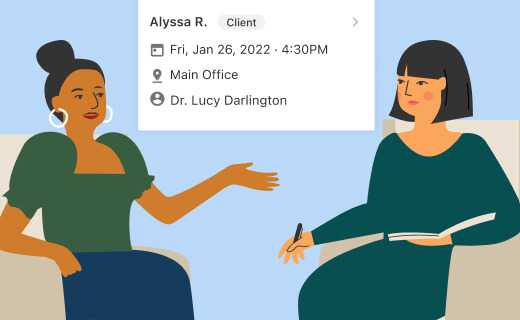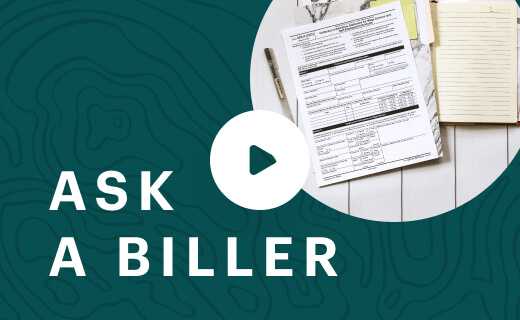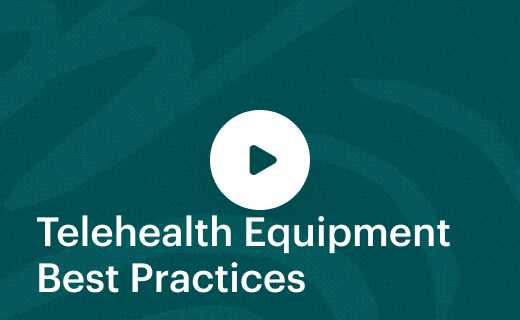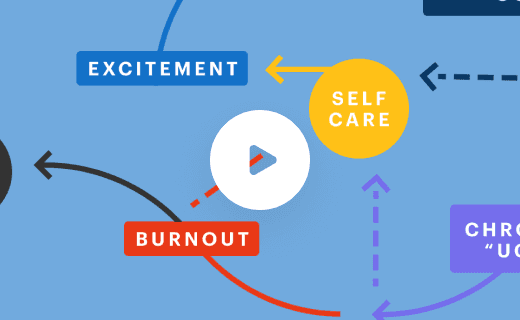Dealing with Insurance Denials
Free 30-day trial, access all this & more:
Want to know about other great webinars?
Join Maggie Gleason from SimplePractice and insurance expert Barbara Griswold, LMFT as they discuss how to deal with insurance claim denials in this Ask A Biller webinar.
They discuss everything from common reasons a claim is denied, to resubmitting a corrected claim. Barbara also answers questions like how to get authorization for out-of-network clients and what should be included in a claim appeal.
If you’re having billing issues and your insurance claims are getting denied, then this webinar has everything you need to successfully understand why it’s happening, and how to resolve it.
- Introductions
- What are some of the common reasons for a denial?
- What are simple mistakes to avoid when submitting claims?
- Is it really worth it to fight a claim denial?
- So what is the first thing I should do when I receive a denial, and in addition, what if it’s a telehealth denial?
- If I made an error, how do I submit a corrective claim?
- How do you get authorized for out-of-network clients?
- Have you had success in getting the insurance company to allow a late-filed claim?
- What if I call the payer and I’m getting nowhere with the claims representative?
- Rather than calling the payer, which can take a lot of time, is there a more efficient way to follow up on a rejected or a denied claim?
- When would I appeal a denial and what is involved? I’ve never done it.
- What should go in my appeal letter?
- Can I submit an appeal if I’m an out-of-network provider or can my client?
- What if my appeal gets denied? What to do?
- What if the denial involves a treatment issue?
- Can claims be denied because insurance deems inappropriate that a client could have the same adjustment disorder for a year or even over?
- Are you coding to the insurance company or are you coding to the actual, to the client and to the treatment?
- How long should claims take? Why does Medicaid take so long? Is 30 days or more normal?
Maggie Gleason: Hi, everyone. Thank you for joining for this webinar, Ask A Biller, dealing with insurance denials. I would like to introduce my cohost, Barbara Griswold, who is a licensed marriage family therapist. Barbara is a practice consultant and the author of Navigating the Insurance Maze. She has been in private practice for 30 years and she has a passion for helping therapists nationwide with the business side of their practice, and as implied in the title, helping you navigate the insurance space.
Barbara Griswold: Hi, everybody. And I wanted to introduce Maggie Gleason, who is a SimplePractice staffer. She has been working in the health care industry for five years and cares very deeply about making health care services accessible to more people. And it says here, “To her, insurance education is a vital element of public health.” So she believes that empowering providers to take on insurance will open the door for many more people to receive care. I’ve worked with Maggie on a number of occasions and each one has been delightful. So I hope you all listen to her. She’s very knowledgeable.
Maggie Gleason: Thanks, Barbara. Happy to be here. Happy to have you here. A little bit of background, we’re going to be talking about insurance denials, so a general overview. What we will not be talking about today is how to use SimplePractice necessarily for insurance claim filing. This will be more general on how to deal with not getting paid by insurance plans. And for those of you who aren’t familiar with SimplePractice, I’d recommend it. It makes filing claims extremely easy. It takes a lot of the human error out of creating and submitting claims and you can automate your claim filing. So try it free for 30 days. If you have any friends that are using SimplePractice, make sure to ask them for their referral link so that you can get $50 and they’ll get $50 as well.
So let’s get started. I wanted to talk through some of the claim statuses that are available in SimplePractice. They’re scrub, accepted, pending. There’s also a rejected state. So rejected means typically that the insurance company has not entered the claim into their system. So it may not require as many steps as we’re going to talk about today which is denied. So denied means that the insurance has looked at the claim, it’s reviewed it and it is saying that it will not pay it unless the claim is corrected or it’s just flat out they’re not going to pay it. So that’s what we’re going to be talking about today, that situation denied. Rejected, similar, you’re not getting paid, but there are less steps involved with getting that corrected.
So without further ado, we’ll get into the questions. Our first question comes from Bronwyn and it is, “What are some of the common reasons for a denial?”
2. What are some of the common reasons for a denial?
Barbara Griswold: For that one, I made a little a little slide on that one, for some common ones. All of us have experienced a thousand different reasons for denial and some of them are just true mysteries. You just never know like, “Why was I ever denied?” but here are some common ones. So first of all, you made an error. I hate it when you call the insurance plan and you’re ready to be up in arms and tell them how stupid they are and it turns out they point out that you made some very small error. And that’s you got to feel foolish. So be careful that you’re not too up in arms when you make the phone call because sometimes it is something that you did.
And often it’s something as simple as a diagnosis code error that you put down, the date. A common date problem is sometimes you put 2020 for the date and it was … Well, excuse me, like for the birth date, let’s say and you’re just so used to putting that for a year. The CPT code might be wrong. Your telehealth codes, maybe you haven’t put the correct modifier or place of service code or you’re missing that, so that’s a new one that’s come up, is that if you’re doing telehealth, you may need to put a modifier that says it’s a telehealth code and the place of service code. So that’s a common one.
And the client ID, sometimes you just mistype the numbers and so they don’t recognize the client in their system. So you might have made some very simple error. So just a good reminder to, before you submit a claim, check all those things very carefully. And some, depending on what EHR, what electronic record system you use or practice management system, sometimes they’ll catch those things up front, sometimes they won’t. Another one is late filing. Most insurance plans give you a window, especially if you’re a network provider to submit claims. And it may be just like three months. You have to submit your claim within three months, let’s say, for that particular plan or else it’s going to be determined to be a late claim. And they call that timely file. It’s not timely filing, they’ll reject the claim outright.
So this is a real reminder that we need to stay on top of our claims which is really hard to do with all the stuff that’s going on right now, that it can’t be something that we kind of, “I’ll take care of that later. I’ll just focus on my clinical work.” Well, yeah, to the expense of you may be not getting paid. Now you, out of network people, have a longer window. Usually, it’s more like a year that people have for out of network, so give your clients something and an invoice and have them submit it, but even those, there’s deadlines, so be careful about those. Also, it could be that the service that the client is seeking or the diagnosis that they’re seeking it for isn’t covered by that client’s plan. And it really does often vary by a client’s plan.
Even within a similar plan, you might have one client who is covered. For example, I have one client who’s not covered for family therapy and she’s an Anthem Blue Cross client, and yet, all my other Anthem Blue Cross clients are covered for family therapy. So you just have to be … You may not know that unless you’ve called upfront and really check it out. Four, you didn’t get preauthorization if needed, this is not a big one because for most of our services, if you’re a psychotherapist, they no longer need preauthorization, but in certain situations, they might. So it’s a good thing to check upfront to make sure that your services are not requiring any kind of preauthorization and be sure you’ve got that.
The client didn’t pay their premium, is no longer covered, this is one that can bite you in the butt and it’s through no fault of your own. Maybe you call up front of the plan, you got all their coverage information and then all of a sudden, it’s rejected because it says the client is no longer covered. They either changed plans and you weren’t told by that, by your client or they didn’t pay their premium and then they’re not covered. I’ve had situations like this where I went to the client, the client said, “Yeah, I did pay my premium and I have proof of it,” and they had to go back and forth back and forth before, they said, “Oh, yes, I guess you did and then I got paid.” But this is another thing that can happen, that you did everything right, and yet, there’s some kind of discrepancy between the plan and the client.
And obviously, the final one, the plan made an error. And that one, you can’t prevent very well. And that one happens all too frequently unfortunately. But I guess one of the things, I just want to … I can point out other possible reasons, but what I want to point out here is that a lot of this can be prevented if you call and contact the plan upfront and try to find out coverage information. And I’m going to tell you what to ask in a minute when you make that phone call so that you’re preventing denials. That’s where we have to move toward because I would say 98% of the reasons that people call me and say, “Oh, my God, I have hundreds of dollars of things that have been denied,” they could have known upfront if they had made that call and asked the right questions. They would have seen this coming and they would have prevented it. So super important to make that call upfront and we’re going to tell you what to ask.
Maggie Gleason: Definitely, and I think just two things to add here. In addition to number one with, you made an error, another big possibility is that your client made an error. So if you are working with someone whose policy is under their spouse’s name, they might not know their spouse’s birthday or they may not know their child’s birthday. I’ve had that happen before where they just get the date wrong or they they’re guessing and then it turns out you can’t get paid until you have that information correct. The next is number five, if your client didn’t pay a premium. Another thing to keep an eye out for is towards the end of the year, your client’s plan may change and they might not be aware or they might not have paid enough attention to their human resource email, or again, it’s through a spouse who didn’t let them know, “We’re switching to United. We’re no longer on Anthem.” And that’s something that is-
Barbara Griswold: Every January 1st or not first, I’m still partying, and then the 2nd probably too, but about the 3rd of January, I come in and I just spend the whole day calling all my insurance clients to make sure that their coverage is still accurate and the same because sometimes their copayments have gone up, but the deductibles have changed. So you just need to read … And not everyone’s on the calendar year plan, but the most are so, yes, good point.
Maggie Gleason: All right, so our next question is, “What are simple mistakes to avoid when submitting claims?”
3. What are simple mistakes to avoid when submitting claims?
Barbara Griswold: Like I said, I think the biggest mistake that people make when submitting claims is just not calling upfront. So many people come back later to me and say … Besides looking over them and making sure your numbers are correct, I think the bottom line is calling upfront, checking coverage and making sure that you’ve done your due diligence upfront. I think, is this where we have the next, the slide, about what to ask?
Maggie Gleason: Yes.
Barbara Griswold: So your freebie tip for today, since you all tuned in and took time out of your busy schedules, is that I’m going to send you … If you write to me at theinsurancemaze.com/contact, you can do it right now, if you know how to toggle over to your mail, not to your mail, but-
Maggie Gleason: Your browser.
Barbara Griswold: Your browser or just write down this address, I’m going to send you the Checking Coverage Handout that I use or that I advise you use. It’s from my book that will tell you the 13 questions that you should ask on that phone call and what information to get from the client before that phone call, so that when you call, you make sure you’re covering all your bases because you don’t want any surprises, you don’t want your clients to have surprises down the line. And also at that website, you can join my mailing list too and get other cool things. But if you want the Checking Coverage Handout, definitely go to theinsurancemaze.com/contact and just mentioned SimplePractice webinar, so I know which freebie you’re looking for.
Maggie Gleason: And this is a great thing to keep stored in your client’s record as well. So you can refer to it anytime.
Barbara Griswold: And then you can just make copies. Is it … You’re asking the question.
Maggie Gleason: So our next question, “Is it really worth it to fight a claim denial?”
4. Is it really worth it to fight a claim denial?
Barbara Griswold: I could talk about this one for half an hour because I feel like so many therapists are overwhelmed as it is. We are backed up with our progress notes. We just, “Oh, my God, a claim denial. I just don’t even think it’s worth it.” People just say, “I’m just too overwhelmed and I don’t really want to follow up. And I don’t even know what to do.” And they’re probably … This whole sense that we have, “It’s so overwhelming and it’s so time consuming and maybe I’m not even going to win,” I am all about not leaving money on the table. I feel like we work too hard. We need to get paid for the good work we do. And I think it’s definitely worth it. I can’t even remember a time that I haven’t eventually gotten paid. So I think most of the time you will get paid if you fight it. Let’s put it that way.
Maggie Gleason: Put the time in.
Barbara Griswold: And some are very easy.
Maggie Gleason: All right, so let’s learn about how we get there. So what is the first thing I should do when I receive a denial, and in addition, what if it’s a telehealth denial?
5. So what is the first thing I should do when I receive a denial, and in addition, what if it’s a telehealth denial?
Barbara Griswold: Yeah, about the same with two questions, so I put them together on that slide. It doesn’t matter if it’s a telehealth denial or a regular denial, it’s the same thing. First, you want to look carefully over the explanation of benefits. So we’re going to call that the EOB. That’s what is that form that comes with your denial, it says, “We didn’t pay anything on this claim that you sent in,” and you’re going to look down and you’re going to look for code next to the date. And allegedly, it’s going to say, “Well, I didn’t deny your claim.” Now, sometimes you won’t understand that, what the words mean that they put because it’s sometimes gobbledygook.
Sometimes the reason that they’re giving is not actually the right one. Sometimes it makes no sense, whatever. You’re going to have to call probably. The bottom line is that gives you a place to start. What I hate is when you call claims or customer service and then they say, “Well, the reason it was denied was,” and then they just read you a ton of explanation of benefits. And I’m like, “Yeah, I already know what you’re saying, but I want to dispute that or I want to hear more about that.” But the first thing you need to do and answer to the question is call the plan. And you can talk to claims or customer service usually and they can sometimes identify if it is an error, if you’re putting forth, “I think this isn’t wrong and this is why.”
Sometimes they can see right away, “Yeah, I can see that,” and it is their fault and they can resubmit it for you and you don’t have to take any further action. So it’s required one phone call in your part that may have lasted, I’m saying allow at least 20 minutes for the call, but after 20 minutes, “I’m putting that in to get paid, so thank you very much.” So sometimes it’s very simple. Other times, it’s going to be a little bit more complicated. Now for that call, be ready with your tax ID and your NPI, so that’s about you. And then you need the client’s insurance ID, their date of birth, their dates of service that you billed for, how much you billed on that particular claim that was denied and the claim number. All of that information is right there. That last part is right there on the claim. So again, just pull your information together and be ready for the phone call.
At the end of the phone call, you want to ask them, “Okay, so you’re saying that you’re going to resubmit the claim, blah, blah, blah,” but ask them to read you their notes that they were taking about the phone call. So if they’re saying, “Okay, this is why it’s being re processed the system. This is what we’re telling the claim processors about the problem,” and ask them how long it should take for you to be paid. Now, they may say, “You made an error, blah, blah, blah, blah, blah, you need to resubmit the claim.” So then don’t forget action item yourself that you need to submit the claim and maybe a corrected claim and we’re going to talk about what that looks like.
Always, always, always get a call confirmation number. Every time you talk to an insurance plan, ask for a call confirmation number. That way, they can look it up if you have to call again or you can sometimes hold them accountable for something they said that was wrong. You can say, “Well, look at your confirmation number. You told me X and it’s actually Y.” I’ve gotten paid on things they told me that were wrong because I had the call confirmation number and I held them accountable for it. Document, document, document, I’m going to say that a lot of times. Whatever they said, the date and time of the call, who you spoke to, get their first name. They don’t usually give their last name and mark your calendar to check back.
If they say, “It will take 30 days for us to reprocess your claim,” mark your calendar for 30 days and then if you haven’t gotten payment, call again.
Maggie Gleason: And if you’re curious about where to find this information on an explanation of benefits, it may be under a different name. You may be looking for an ERA which is an electronic remittance advice. It’s just another way of saying explanation of benefits, but it’s online. So if you aren’t receiving this by mail, you may receive it in your provider portal through the payer or you may actually be able to see all this information within SimplePractice if you’re set up to receive your ERA is through there.
Barbara Griswold: Good point.
Maggie Gleason: And if you’re not receiving an explanation of benefits, that’s a hint to call the payer too. If you’re not getting paid, you’re not receiving explanation of benefits, there’s something going on. So next question, “If I made an error, how do I submit a corrective claim?”
6. If I made an error, how do I submit a corrective claim?
Barbara Griswold: All right, we’ve put together a slide. It doesn’t matter if you’re the one who made the error, you can still submit a corrected claim. And if you use the CMS-1500 form or if you do it online or whatever, I cut out the part in the middle here that you’re going to be using for a corrected claim. So can you click it again?
Maggie Gleason: Mm-hmm (affirmative).
Barbara Griswold: So here in number 19, which is a box we don’t usually use, you’re going to use for explanation. You’re going to say why are you submitting it. So you’re going to submit a claim that is exactly how you wish you had submitted it for the first time. So if you put the wrong CPT code, or in this case, this person put the wrong place of service code, on the original claim, they were submitting for telehealth, but they put place of service code for an office visit instead of a telehealth visit. So they, “Oh-oh,” so they are wanting to resubmit it and put the correct place of service code. And so they’re telling this way they’re correcting it and then they’re saying, “Hey, I’m resubmitting this claim,” box 19, there is your explanation. “There was an incorrect place of service code on the original claim.” There’s no magic words to put here, just say it in human language what it is you’re wanting from them.
Barbara Griswold: Then over here in box 22, they’re going to write a seven, which basically just means, “This is a resubmission.” And then right next to it, if you click a little more time, click it, here we go, is where you put-
Maggie Gleason: Where did it go?
Barbara Griswold: There we go, the original reference number which is basically the original claim number. I wish they just wrote original claim. So whichever is the claim you’re replacing with this corrected claim, just put this there. So this tells them, “Look back to that. That’s being replaced by this one.” You don’t have to submit the original claim with this corrected claim. I hope that all makes sense. And if not, write to me and I’ll try to explain it better.
Maggie Gleason: I think this is a really important note on corrected claims. So let’s say you submit a claim and you know as soon as you submit it that you did something wrong and it’s going to come back denied. You have to wait to be able to submit a corrected claim. You can’t correct a claim until you have that reference number from the payer. If you try to submit two claims for the same date of service, you will get denied out as trying to double submit a claim. So let’s say you knew right away, you still have to wait in order to go to correct it unless you can contact them and have them, usually don’t bother.
Barbara Griswold: Don’t bother. They’ll see this a duplicate claim. They’ll think they already processed it. And they’ll just say, “Oh, we already processed this claim. You’ve accidentally submitted two,” and they’ll just deny the second one out of hand. So that’s why you need to put these into say, “This is different.” But it’s-
Maggie Gleason: So I’m going to talk about how to do that on SimplePractice. So in that scenario, you have submitted a claim, you know it was wrong or you didn’t. It came back denied. You have the original reference number. So the first thing that you want to do, you’ll pull up your claim that has this denial on it. You’ll need to record the claim reference number. That’s at the top of the claim form. It will be recorded strictly right there as the claim reference, and then, it will also be on your explanation of benefits if you want to double check to make sure you have the same number. The next thing you’ll do is download the denied claim and store it in the client’s record. So that’s if you ever need to refer back to that claim to say, “Look, I filed it on this day.” That will all be recorded when you download the claim.
And then you’ll want to store that in the client’s record. Do not store this file on your desktop or in your computer, as it will contain client information. So you don’t want to have a breach of privacy. The next thing you’ll do is delete that same claim that you just downloaded. So you’ll need to clear out the original claim that was denied in order to be able to submit a new claim for that date of service, so you can only have one claim for each date of service unless you’re submitting as a secondary. So delete the original claim and create a new claim. When you create a new claim, there you’ll be able to manually edit the boxes that Barbara showed us before, box 22, box 19. You’ll simply select resubmission that automatically codes it as a seven, a resubmission and then you’ll include the original reference number just to the right of that.
And that’s where you’ll put that number that you saved before and here’s where you can submit a followup to make sure it gets paid. All right, so our next question is, “What if the denial reason was no prior authorization?”
Barbara Griswold: So as I said before, most of our like therapy services don’t need prior authorization, so sometimes this is an error. I have seen times when I’ve had to just call them and they’re like, “Oh, that’s right. Your service doesn’t need prior authorization and we’ll resubmit the claim.” So it could be something simple like that. If it’s something you call, they’re like, “Oh, yeah, actually, they didn’t need prior authorization,” see if you can get them to backdate it to cover your services.
This is another reason why you should submit claims very quick after the sessions because if there are issues, you want to know about them right away. For those of you who bill monthly or every other month or every third month, this is not a good idea because you’re not going to find out about changes or problems or people who didn’t pay their premiums until a big debt has built up. So the same thing with preauthorization, so you want to submit especially your first session very soon. So you can always call and see if you can get authorization and try to get it back dated.
Maggie Gleason: All right, our next question, “How do you get authorized for out-of-network clients?”
7. How do you get authorized for out-of-network clients?
Barbara Griswold: Same thing. Again, most people don’t need authorization and out-of-network clients may not need them. If the client has a PPO, a preferred provider organization plan or POS plan, usually they don’t need authorization. I don’t know if this person is asking about a single case agreement situation. So that’s totally different, but I’ll call the clients plan and talk to them about what’s needed.
Maggie Gleason: All right, and, “My longer session, so beyond 46 and 60 minutes, keep getting denied, any advice?” That is Michelle.
Barbara Griswold: This can be a lot of different reasons. Michelle, you may want to contact me directly, but it really depends how you’re on … A number of things, for example, what codes you’re using. Most insurance plans don’t want to pay more than 40, 45 or 60 minutes per day. Let’s start with that. So if you are trying to bill for longer sessions like two units of 45 minutes or two units of 60 minutes, you’re probably going to get denied. The client’s coverage may not cover more than one session per day. If you’re using prolonged service codes like the 99354, 99355, insurance plans may not cover that for therapists. It depends on the client’s plan. You have to look into that. It may not be in your contract as a covered code.
If you want to find out more about that, I do have articles on my article page at theinsurancemaze.com/articles and look at longer sessions or billing for longer sessions, but for the bottom line, bottom line is insurance plans typically do not like all your sessions. They don’t usually deny it upfront, except those prolonged service codes. But the one that we all know, United Behavioral Health and Optum particularly, take a stance against 16-minute code, the 90837. They will sometimes agree to pay for some, but you’re usually going to get a phone call to find out why you’re doing them. And they usually only allow them for special circumstances.
Maggie Gleason: Or they may lead you down a rabbit hole of prior authorization that they likely won’t grant.
Barbara Griswold: Right.
Maggie Gleason: That’s one thing to be aware of. “If I submit a 90847 for a family session and the insurance denies the claim, can I resubmit the charge as a 90837?”
Barbara Griswold: No, absolutely not. Thanks for asking, Pamela. I’m glad that you want to do things ethically. Basically, if you provided a family or a couples session, 90847 is the appropriate code. You cannot then … It doesn’t matter whether you got denied or not. You can never use the 90837 because that’s not the proper code for a family or couples session for ongoing couples and family sessions. The only time you can use a 90837 for a family or couples session is if you’re doing individual therapy with somebody ongoingly. And maybe for a session, you bring in their partner for part of the session occasionally or one time or whatever, that you’re doing ongoing … Individual is the primary mode that you’re doing and you’re just bringing him in for a one session. That would be the only way that you could resubmit for that session under a 90837. And again, you’d have to use the corrected thing that we talked about before. You’d have to say, “Incorrect CPT code utilized.”
Maggie Gleason: All right, “Have you had success in getting the insurance company to allow a late-filed claim?”
8. Have you had success in getting the insurance company to allow a late-filed claim?
Barbara Griswold: Sure. Not myself, but I’ve talked to and coached other people who have. You can throw yourself on their mercy, and sometimes if you’ve been … It has to be a good reason for them to allow it. Sometimes if you’ve been in the hospital, right now during coronavirus if you’re were or the fires that are happening or flood or something, if you’re able to get to your office, I’m not sure how nice they’re being about that right now, but if you had a really good reason, if it was or … It could be usually something medical in your family or some kind of emergency. If it was just, “I was overwhelmed,” I don’t think they’re going to take that. But definitely, it can’t hurt again to ask and to file an appeal and we’re going to talk about what to put in your appeal. And so you just make your case and it can’t hurt to ask.
Maggie Gleason: And one thing I’ll say is which is a really solid reason is if you’ve been submitting to the wrong place, so if your client gave you incorrect information or if you just misinterpreted the ID card and you did submit within technically the timely filing, you were just getting it wrong for so long, then if you can show intent to submit within timely filing, they will usually let that slide as long as you save and that’s why it’s important to download any claims that that had been denied and you need to clear out, so that you have record of like, “This was submitted within the six months you gave me. It just wasn’t going to the right place.”
Barbara Griswold: But you bring up a really good point which is don’t … In my mind, I have three rules. Don’t believe anything on the client’s insurance card because it doesn’t always apply to us. Sometimes there’s a carve out to some other insurance plan, meaning some other insurance plan is handling the mental health or the address on there is for medical claims, but not for mental health claims or whatever or it says a $20 copayment and actually it’s $10 for mental health or whatever. Never believe anything on their cards.
That’s why you need to call upfront. Never believe anything that a client tells you about their insurance is my second mantra and only sometimes believe what they tell you on the phone. So those are my … I think the phone, you need to always call upfront. So if you get into trouble because you have believed something that a client has told you or because you believe you misinterpreted their card, that’s a little bit on you, I think. We always need to call and verify.
Maggie Gleason: And don’t stop until you get the right information, so “What if I call the payer and I’m getting nowhere with the claims representative?” That was a nice lead in.
9. What if I call the payer and I’m getting nowhere with the claims representative?
Barbara Griswold: Sometimes you talk to somebody and they just clearly don’t know what they’re talking about or it’s going round and round. Ask to talk to their supervisor. And you usually can’t skip ahead and say, “Look, can I just talk to your supervisor? I’ve called about this before.” Usually, you still have to talk to the claims representative when you’ve called, but if it’s going nowhere, ask to talk to their supervisor.
Maggie Gleason: I also ask if I’m really getting the runaround or getting passed off to different departments, I will ask the person who’s about to pass me off to stay on the line until we can confirm that I am in the right hands. So if they’re going to tell me, “This needs to go to this department.” “So okay, great.” “Let’s just make sure. I want you to stay on the line until”-
Barbara Griswold: And always ask for the direct line of the person that they’re transferring you to, so that if you get cut off, which happens so often, you can call back that direct line of who they’re sending you to. They’re usually giving that.
Maggie Gleason: This is really great for carve-out plans too. And they say, “Okay, this is United Behavioral Health.” Sometimes if the United Behavioral or someone tells me, “That’s not us,” I will three-way call in all of that. I’ll try to have, “Okay, so let’s make sure we’re on the same page here. I want to make sure everyone has the right information.” I tried in any area if I have to make phone calls not just with insurance.
Barbara Griswold: Good.
Maggie Gleason: So the next question is, “Rather than calling the payer, which can take a lot of time, is there a more efficient way to follow up on a rejected or a denied claim?”
10. Rather than calling the payer, which can take a lot of time, is there a more efficient way to follow up on a rejected or a denied claim?
Barbara Griswold: I would say no. I know it could take time, but I don’t I believe things … If there’s really not a good source online that I know of that I trust to follow up on a rejected claim. I don’t know if you have different thoughts about that, Maggie, but I would say, nope, calling the payer still and talking to somebody about the whole situation is my go-to.
Maggie Gleason: Unless it’s a really simple denial that you’re used to and you know what to do. I would err on the side of calling and speaking to someone. And that will just get you paid faster and save you more time in the long run, rather than putting off the time that you’ll have to call and follow up anyway. So I would budget time if you can just to make those calls. Next question, “How frequent are clawbacks? I hear about them all the time, but it does not seem to happen in my state.”
Barbara Griswold: So clawback is when money is requested back from the provider or from the client and because the insurance plan feels that they paid something that they shouldn’t have paid or wouldn’t have paid if they had known all the details correctly. People are very frightened about these particular providers and you hear these horror stories about insurance plans coming in and asking for thousands of dollars back. It does happen, but I would say it’s very rare. Usually they go after agencies and hospitals where they’re going to get back a lot of money. You and your little office are usually pretty small potatoes. And what they’re looking for … The clawbacks I hear are almost always fraud. They have looked in and they have found some type of fraud.
Now the closest that you guys probably are coming to fraud, and that’s why I want to talk about a very quickly here, is it’s more that you don’t probably don’t know about this is that they look very carefully at your start and stop times that you are recording. You need to be writing the actual start and stop time for each session that you have, not 1:00 to 1:55. Every time they see that, they don’t believe it. If it’s 1:01 to 1:54 for one week and the next time it’s 1:05 because the person was five minutes late or it took you five minutes to connect to 1:52, this is more believable to them, and hopefully, it’s also more accurate. And if they see the same thing every week, they may look at you and wonder whether you are fraudulent billing.
Also they’re going to look to see if every once in a while, probably your client’s 10 minutes late and you should be down coding for that session because you didn’t do probably a whole, let’s say 53-minute session which is what a 60-minute code requires. Maybe you had to do a 45-minute session. So if every once in a while they see that you billed for 45 minutes, they’re going to look to see basically that the number of minutes that you’re reporting match the number of minutes that you’re billing for. You can’t bill for a 60-minute session if you provided a 45-minute session because they were 15 minutes late. So again, that would be considered in their mind fraud.
So these are the kinds of things that just a quick moment there just to say this is important thing for you guys to pay attention to. Yeah, it’s not a frequent thing and I wouldn’t worry about it. Just focus on that, being honest, not billing for sessions that didn’t happen and keeping good records.
Maggie Gleason: And that fraud is another webinar for another day.
Barbara Griswold: We’re going to-
Maggie Gleason: That we’ll go into. So, “When would I appeal a denial and what is involved? I’ve never done it.”
11. When would I appeal a denial and what is involved? I’ve never done it.
Barbara Griswold: Well, I put together a little slide for you, Taylor.
Maggie Gleason: All right.
Barbara Griswold: Well, what is an appeal? Actually, what does that mean? Appeal or dispute, can be called different things, is basically a letter to the insurance plan and you’re either challenging a denial. You’re saying, “I think that was denied an error,” or you say, “I know that you have these plan policies, but I want an exception,” and then that could be one of those like, “I know I’m was more than 90 days late submitting, but here’s my explanation,” or, “This particular client needs this because of these reasons, even though it’s not covered.” So it can be any kind of reasons that you’re explaining to them why you think this needs to be specially looked at.
And I have a sample appeal letter in my book. The explanation of benefits basically should give information about where to send your appeal. And you noticed I say, “Should give information.” I always call because sometimes it’s very confusing and d the information on the explanation of benefits is not always correct interestingly enough, but just call and just say, “Where do I send my appeal for this particular person?” Contact the plan for details just about the appeal process. They may even sometimes tell you what to include, what address is and what the deadlines are. Because there is a deadline on the appeal. You can’t just like put that on your pile like, “I’ll get back to that in six months and then I’ll appeal it,” because sometimes you need to appeal it within a certain number of months. And if not, your window’s closed.
Maggie Gleason: And how often do you recommend following up for an appeal?
Barbara Griswold: You mean after you filed your appeal?
Maggie Gleason: Yes.
Barbara Griswold: Well, if they say they’re going to tell you … They sometimes will either send you a letter saying, “We’ve received your appeal and we will get back to you about it,” but I think they’re required within … In California here, they’re required to acknowledge your appeal within 30 or 45 days or something like that. So it depends on your state, but the hard thing about appeals, it’s hard to reach anyone to talk to about them like, “What is the status of my appeal?” is almost an impossible question to get answered by any insurance plan. They have made it so you can’t talk to people in the appeal department. It’s hard to see if they’ve received it. It’s hard to see what the status is. I don’t have a good answer for that.
Maggie Gleason: But it’s still worth doing when you-
Barbara Griswold: Yeah, definitely follow up if you haven’t heard back from them. I would say 30 days is always my little go to.
Maggie Gleason: I always say within 30 to 40 business days, as they tell you, but all right, so we’ll talk a little bit about, “What should go in my appeal letter?”
12. What should go in my appeal letter?
Barbara Griswold: So always you have to cram it full of details about the client’s name, ID, date of birth, dates of service, total amount billed on that particular claim, the claim number that you’re dealing with. Again, details why you think it was paid an error or why you want the exception. What steps have you taken to try to resolve it already? Go back to document, document, document. All those call confirmation numbers. “On May 22nd, I talked to Sheila S., your customer service, and she told me this is this and then it didn’t happen. And then …” So just lay it all out. And any copies of relevant documentation which might be the copy of the claim. You can print out a new fresh copy, that’s fine or the explanation of benefits or anything you have that’s relevant, any documentation you’ve gotten from them about why. Maybe you got a letter from them.
Maggie Gleason: All right, and, “Can I still submit an appeal of it was my error that led to the denial?”
Barbara Griswold: Absolutely.
Maggie Gleason: One-word answer. Great. And a lot of questions about appeals, “Can I submit an appeal if I’m an out-of-network provider or can my client?”
13. Can I submit an appeal if I’m an out-of-network provider or can my client?
Barbara Griswold: Yeah, definitely. And definitely your client can and definitely you can. So it’s short answer there that you can submit on your client’s behalf. Hopefully, as an out-of-network provider, you’ve been paid already, but you’re advocating for your client and helping them get paid. The client can also write a letter for themselves and appeal, but frankly, I think you’re usually in a position to argue more effectively than clients. They don’t usually know what to say. They don’t know about codes. They don’t know.
So when I’ve seen client appeal letters, they’re just kind of like, “I’m a nice person and I should be paid for these sessions.” They don’t really understand you got to throw in some buzzwords like, “This was medically necessary services and I provided them in good faith,” and whatever. You want to throw in some buzzwords like that, but also you want to make a little bit more about coverage and CPT codes and whatever the problem was.
Maggie Gleason: I would say, again as Barbara mentioned before, use a template, save yourself the time. Don’t start from scratch every time. There’s one available in her store, but use a guide so that every single time you know you just need to fill in the information for that particular client in that particular claim. All right, so, “I’m an out-of-network provider and my client is asking me to appeal on her behalf. I don’t want to deal with this. Do I have to?” That’s Michael.
Barbara Griswold: So I get this question a lot. People are telling me, some providers are saying to me, “Look, I’m not out the money, doing an appeal is a lot of a lot of work. I don’t really feel like … This is why I didn’t get involved with insurance plans, is something I have to do.” And what I would say is, “No, you don’t have to do it, but many professional organizations or ethics codes require you to do it.” And legally, I would say, this is my morals, is that I believe that part of our profession is about advocating for the care and helping our clients as much as we can.
And to me, this is something that’s part of our job is assisting our clients to get reimbursement so that they can make our services more accessible. So again, there may be some legal issues there depending on your state, but it’s probably more ethical, ethically. Your ethical codes may require you to, I know, in camps, there is ethics code that does require us here in California, for marriage and family therapists, to advocate on our client’s behalf for treatment. It doesn’t specifically say for payment, but so you guys can figure it out what that means to you.
Maggie Gleason: And if you have the right recipe, it shouldn’t be a big task to do.
Barbara Griswold: Well, I will say it’s not a small task either because each one is a little bit different. If you write five appeals, they’re going to be a little bit different for different reasons.
Maggie Gleason: All right, so the next question is, “What if my appeal gets denied? What to do?”
14. What if my appeal gets denied? What to do?
Barbara Griswold: So here are some options I wrote out on this slide. The client could get their employer benefits manager involved. I’ve had that happen a couple times and it’s been wildly effective. A lot of employees don’t have benefit managers anymore. They were the first to go in all of these cutbacks, but sometimes if they work in a big organization, basically if benefits … Say the client can get them, don’t you be reaching out to a benefits manager, but if the client goes their benefits manager and says, “Hey, we’re having trouble. My provider isn’t getting paid for services that she did or whatever,” sometimes benefit manager calls up the insurance plan and says, “Hey, basically what’s going on with this?” and puts a little leverage.
And you have to remember that the benefit manager represents the employer who pays the premiums to this. And they want to keep the employer happy because the employer, if they get enough complaints, can choose a different health plan next year, right? So sometimes they have more leverage than you do. I twice had this happened where the client went to their benefits manager and I got a check the next month. So suddenly, it appeared, something that they were able to put some leverage on. You can contact your professional organization and see if they can be helpful, to see if it’s a bigger issue that’s going on.
You can certainly hire a professional insurance consultant like myself. And again, this is after you’ve tried to appeal, you’ve got denied. You’ve appealed, it’s been denied. You can appeal to your state’s Department of Insurance or Department of Managed Health Care here in California. Some states have a Department of Managed Health Care. Now the first thing you need to do though is figure out who has jurisdiction, basically who’s the boss of the health plan that you are dealing with. I have some self-insured plans who they are actually under the Federal Department of Corporations that I have to go and appeal to them, but the basic thing is I’ve several times complained to the Department of Managed Health Care about a client or about health plan and they’ve leaned on the insurance plan and then I’ve gotten paid so. And you can do this for treatment or payment issues.
And again, you fill out like I did, I filled out an online complaint. So you just copy and paste whatever you put into the original appeal. You don’t usually have to do much extra work and then attach the same information and see if they can go to work for you. And the last one I put on here, and frankly, I don’t have experience with this one, but it’s something that I don’t know if it might work. I’ve been hearing about patient advocates and I found this website for Patient Advocate Foundation and they’re nonprofits and they supposedly help clients. So it might be a resource. Again, I’m not advocating it because I don’t know about it, but it’d be something to look into if your clients are having trouble getting reimbursed.
Maggie Gleason: All right, so our next question is, “What if the denial involves a treatment issue?” This is something for Travis.
15. What if the denial involves a treatment issue?
Barbara Griswold: So let’s be clear. So what we’ve been talking about up until now has been mostly like a coverage or a payment issue. This is what if they’re saying to you, “Yeah, we don’t think that the client should have any more sessions or we think that you should like decrease frequency, the client, or we just don’t think that it’s medically necessary the work that you’re doing So we’re just not going to pay for anything more.” So you could appeal this and write … Your appeal should be arguing, “How are these sessions or session frequencies medically necessary?” This is a term I keep using medically necessary. Basically, medical plans, health plans do not pay for any kind of sessions that they don’t think are medically necessary. That’s the key buzzword.
They have a medical necessity criteria that is in there, usually in their provider manual. So if you look it up on their website, under the provider manual and just look under medical necessity criteria for outpatient mental health, you’ll find their criteria. But pretty much they need to believe that it’s treating some diagnosis in the DSM other than a Z code. It can’t just be a Z code. It’s got to be something like anxiety or depression and that the frequency is actually necessary for the level of severity and the type of functioning problems your clients having, that they believe it’s the most cost effective. You have to argue why this person couldn’t like just be in a support group maybe and how it’s preventing more intensive treatment, that type of thing.
And definitely you want to outline your treatment goals and plan that you have. And if you needed to you, you don’t want to keep this client hanging while you appeal. You can often ask for an expedited appeal. I wanted to say that if you go to the state to the Department of Managed Health Care, they usually will want you to have exhausted your appeals at the insurance plan first before you go to the state. But sometimes you could go to the state if there’s an expedited situation where you need to see the client and you can’t like wait long periods of time while you get this all worked up.
Maggie Gleason: And our next question is, “Can claims be denied because insurance deems inappropriate that a client could have the same adjustment disorder for a year or even over?”
16. Can claims be denied because insurance deems inappropriate that a client could have the same adjustment disorder for a year or even over?
Barbara Griswold: Well, I would say that you would have to defend why you’re using an adjustment disorder diagnosis for that long. If you’ve had a client for example who has had multiple different things that they’ve been adjusting to over the course of the year, which is true for many of our clients over especially in 2020, many of them were dealing with something when they came into treatment and then COVID happened and they’re dealing with maybe the loss of their job or they’re dealing with the loss of shut all the shelter in place things, adjustments that have come along with them or whatever, if you can show that there’s a series of adjustments, that they are things that they’re adjusting to, I think that’s where you’re going to be fine.
I have never seen it happen that that they’ve said, they’ve taken away … I use adjustment disorder a lot because that’s the appropriate one with my clients and I’ve never seen that they’ve said, “We’re going to take it away because you’re using adjustment disorder for a year.” It’s more, “What are the level of their symptoms? And what are the things they adjusting to?” and make sure that you’re not just under diagnosing though. If you have clients who you’re just using an adjustment disorder, they actually have something more severe going on, but you’re using that because you want to not use anything hurtful-
Maggie Gleason: You don’t want to rock the boat.
Barbara Griswold: Well, you don’t want anything in their charts that maybe you don’t want, “Oh, I don’t want to put depression down. I’m going to put something more innocuous, more innocent,” that can cause you problems because later you want to get more treatment for them and they’re like, “Hey, this person’s had adjustment disorder for five years,” whereas if you had been honest and said, “No, they’ve actually been dealing with an anxiety disorder,” it would be easier five years from now or three years from now to get the treatment that they need. So be honest about what you’re treating.
Maggie Gleason: And the alternative that I’ve seen is people not wanting to change what they’re coding because it’s working and they’re getting paid. And so I think that’s also something to be aware of, “Are you coding to the insurance company or are you coding to the actual, to the client and to the treatment?”.
17. Are you coding to the insurance company or are you coding to the actual, to the client and to the treatment?
Barbara Griswold: And it may be that some people … So some people no longer have the same diagnosis they had when they came in and you have to just talk to them and say, “Hey, you no longer have an adjustment disorder. It seems like you’re doing pretty well. I’m happy to keep continuing to work with you, but I can’t, in good faith, keep billing the insurance plan. That’s kind of fraud and I could lose my license. That’s how I present it. So let’s keep working together. I hope and can we keep doing this without billing your insurance because I can’t, that’s fraud?” So freebie reminder, just right now, write down the insurance maze.com/contact, and mention SimplePractice and I’m going to send you that Checking Coverage Handout, just from my book.
You can also just join my mailing list and I have an email newsletter that goes out twice a month, excuse me twice a month, that’s ideal, or twice a year depending on how interested I am in doing it or how busy I am. And I think we’re going to take five minutes more of questions. Is that what’s happening?
Maggie Gleason: Yeah, so the first one we have and we touched on this a little bit, but medical necessity is a broad term, “How do I know we’re proving it accurately?”
Barbara Griswold: Like I said, insurance plans have very common across the board ideas of what it means. So the one thing they had seemed to agree on is what medical necessity, but it is very vague. Each one of them are vague about it, so they can … So usually it means several things. Like I said number one, that your client has a DSM-5 diagnosis other than a Z code, more than a Z code, which should say. And usually sexual issues are not enough, but usually adjustment disorders are. They don’t usually see sexual disorders as anything but discretionary like, “That’s just something to make our lives better. We don’t really need a better sex life.” Again, they’re only looking at medical disorders like anxiety disorder, depression, insomnia, substance abuse, something like that.
Then they’re going to look at, “Is this the most cost-effective level of care? Should this person be at a higher level like a hospital or lower level like a self-help group?” You have to argue why yours is the best level of care, the best frequency of care. “Is it a traditional … Is it the best type of treatment for the type of problem that the client is having?” It may be that they think aromatherapy is not really the best type of therapy for someone with an anxiety disorder or drumming is not the best type of treatment in their minds for someone with depression. So they’re going to look at what they think is clinically scientifically supported. So they’re looking for evidence-based care.
They didn’t use to support EMDR. Now, they support EMDR. So if you have something, you might have to sell it to them. They’re going to look for things like if this person is, what else, medically necessary. So those are kind of the basics is this person has to be showing symptoms and the symptoms have to be impairing their function in some way. So it’s not enough to say, “My client is going through a divorce.” Some people are going through a divorce and they are not having symptoms that are impairing their functioning. And it can be very light impairment. It can be, “They’re having trouble focusing at work or not being as productive at work or they’re more irritable at home or whatever,” but bottom line is you need to be able to explain how their symptoms are impairing their functioning in different areas of their life. So that’s a quick and dirty overview of medical necessity.
Maggie Gleason: All right, our next question is, “How long should claims take? Why does Medicaid take so long? Is 30 days or more normal?”
18. How long should claims take? Why does Medicaid take so long? Is 30 days or more normal?
Barbara Griswold: Yeah, I don’t know why different ones take long, but yeah, 30 days is definitely normal, even for electronic billing.
Maggie Gleason: And it’s very subjective to the payer that you’re working with. So it depends on if you’re set up for automatic payments. If you’re getting them through direct deposit or if you’re waiting for a check in the mail, that may take even longer. All right, so I think we’ll take one more question. “When should we cancel a claim and resubmit versus just send a corrected claim?”
Barbara Griswold: That’s probably a SimplePractice question. If you’re not in SimplePractice, you don’t need to cancel a claim. You just submitted another one and just refer to the original one and say, “Basically, I’m replacing the original one with this corrected claim.” Maggie, you filled it for SimplePractice.
Maggie Gleason: So if your claim is rejected and it does not have an updated claim ID, then you can just submit a new one. If it’s scrubbed, then you can just delete that and create a new one. Pay attention to the claim status. If you’re not sure, check with the payer to see whether or not they’ve received the claim. If they haven’t received the claim, then you’re good to just cancel that and send a new claim.
Barbara Griswold: Sometimes you’re going to see that it was denied due to coordination of benefits or something like that. And that’s another thing we didn’t talk about which is basically that they need to find out if the client has other insurance that might be paying for this. We talk about secondary coverage, but sometimes they don’t, but they just need to ask you before they … So make sure that if you see the words coordination of benefits as the code like why this has been denied, usually a client just needs to call the insurance plan and tell them, “No, I don’t have other insurance,” or “Yes, I do and this is what it is.
Maggie Gleason: All right, so we’ll wrap up here. Thank you so much to everyone that joined us and thank you to anyone who is watching the recording.
Barbara Griswold: Bye, everyone.
Build the best practice you can.
Our resources to help you & your practice take the next step.











































